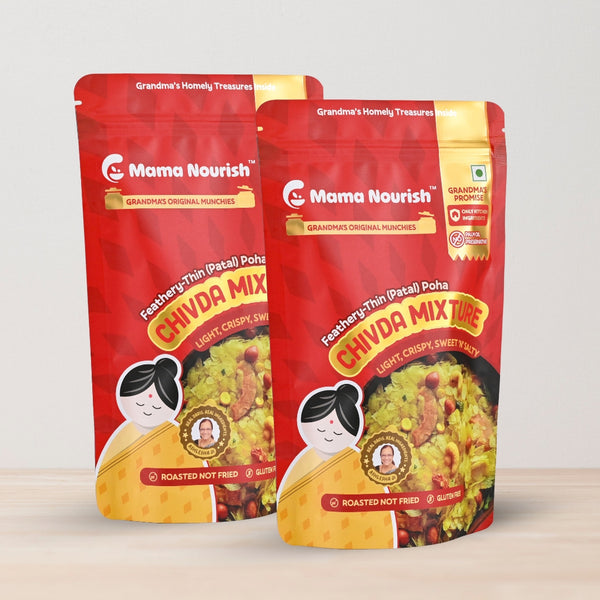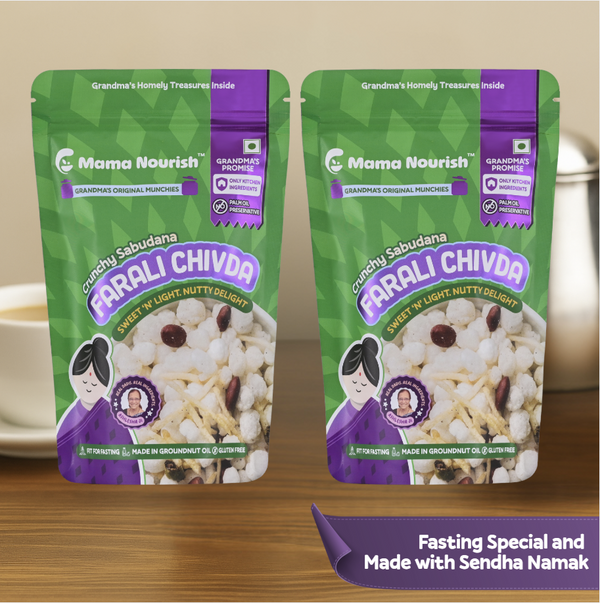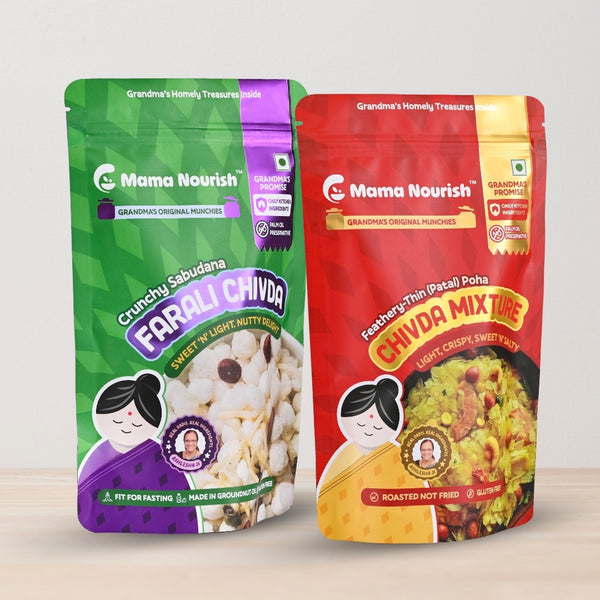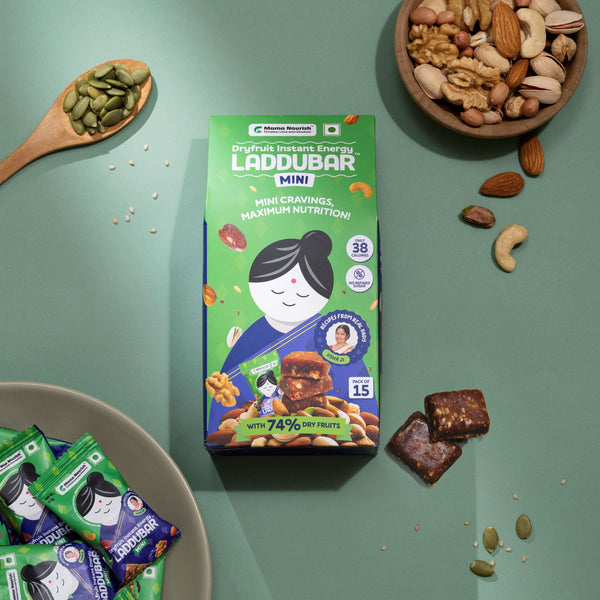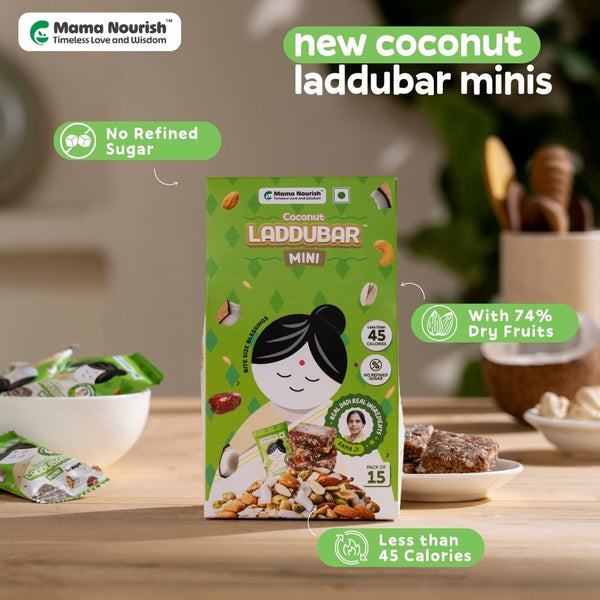Nourishing Trails
Recent Post
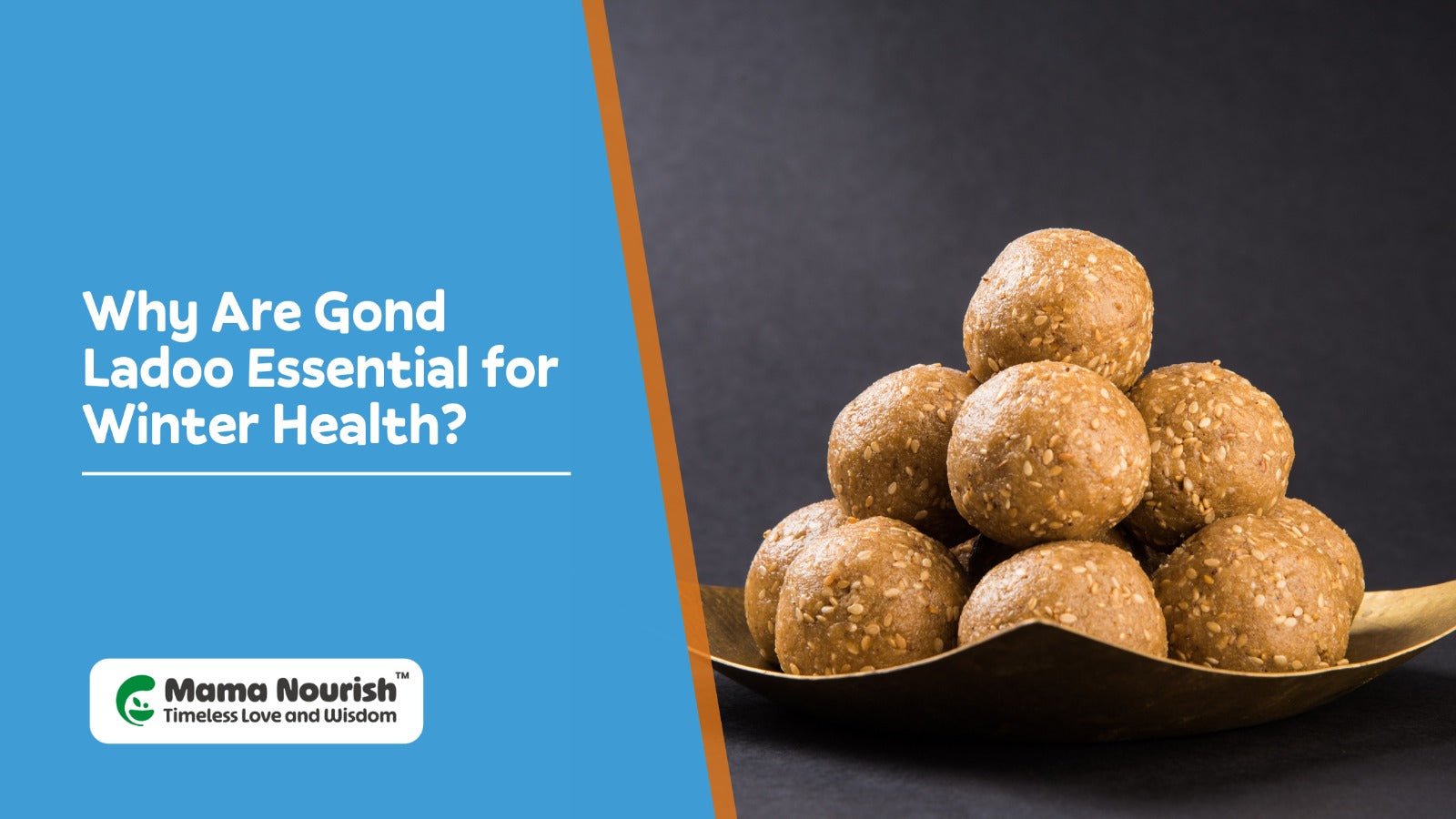
Why Are Gond Ladoo Essential for...
It's winter season again, and naturally, we crave warmth and energy boost to get over the seasonal lethargy. Many traditional winter treats in our country are not only tasty but also have many health benefits. One such warming treat is Gond ke Laddu–made with gond or Gum Arabic, dry fruits, and other kitchen ingredients like cow ghee and whole wheat flour.
Before going to the health benefits of gond laddu, especially for the winter season. How about we get to know more about gond?
What is Gond / Gum Arabic?
Gond or gum Arabic is a Gum extracted from the gond acacia tree, locally called Babul. The gond has been an ingredient in Indian cuisine and is especially known for its health benefits, even for new mothers during their postpartum recovery.
Gond for winter offers numerous health benefits, including aiding weight loss by reducing fat percentage and BMI while providing a satiating effect. It has antioxidant properties that boost immunity, especially in winter, and as a soluble dietary fiber, it improves digestion. Gond supports cholesterol management by lowering cholesterol levels and blood pressure, and studies suggest it enhances kidney and liver functions. Additionally, it is recognized as an anti-diabetic ingredient.
To know more about the health benefits of gond you can check our previous article on health benefits of Gond.
The traditional Gond ke laddu is made by combining this nutritious ingredient with dry fruits, wheat flour and ghee. Seeds like pumpkin and melon seeds and spices like ginger are added for additional health benefits.
Gond ke Laddu Health Benefits for Winter Season
1. Boosts Immunity
In winter, it's important to boost the immune system to avoid seasonal flues. The gond laddus provide essential nutrients that enhance immunity.
As we discussed earlier, gond benefits in winter due to its rich antioxidants, strengthening the immune system and helping the body fight seasonal illnesses.
The nuts like almonds, cashews and walnuts used to make gond laddu also contain antioxidants. In fact, the almond contains vitamin E which is important for immune function. Similarly, walnuts are good for the heart and may help in dealing with metabolic disorders–overall, they promote a healthy immune system due to antioxidant properties.
2. Provides Warmth to the Body
Gond ke laddu for winter is a traditional winter delicacy. The Gond is believed to be a natural warming agent that helps maintain body temperature and prevent cold-related discomfort.
Additionally, the cow Ghee added to make gond laddu is considered a warming food, making it an essential traditional ingredient in winter recipes. Ayurveda considers ghee as a warming food. Taken in moderation, ghee provides holistic wellness.
3. Strengthens Bones and Joints
Winter often causes joint pain and stiffness, particularly for the elderly. Gond ladoo benefits include being a natural remedy for maintaining joint and bone health. The gond is known for improving calcium absorption from the digestive tract, an important element for bone development and health.
Almonds in Gond Laddu are another important food source packed with calcium. Plus Ghee is a healthy fat source that nourishes joints and reduces inflammation, offering relief from winter aches–another bonus point.
4. Boosts Energy Levels
Gond ke laddus are an excellent source of energy, helping you combat winter fatigue. Both ghee and nuts provide healthy fat. These act as a concentrated energy source, ideal for cold mornings when extra fuel is needed to stay warm and productive.
Dates, figs, or raisins can be added to supply quick energy without overloading on refined sugar. This makes gond laddus a wholesome and energizing snack, perfect for busy bees.
5. Improves Digestive Health
Digestive issues such as bloating and constipation, are common during winter due to heavier meals and reduced activity. Gond laddus is a natural digestive aid.
Plus gond supports gut health by acting as a prebiotic, encouraging the growth of beneficial bacteria in the gut.
Ghee is Known for its soothing effects on the digestive tract. According to studies, Ghee contains butyric acid, which is a short-chain fatty acid (Kumar et al., 2015), thus contributing to ease of digestion.
In addition to the above benefits, gond laddus is good for the skin. Plus, it's a traditional postpartum recovery recipe recommended for new mothers.
So, what's stopping you from adding gond laddu to your winter pantry? If you are finding it difficult to carry or eat gond laddus on-the-go or have no time to make it at home you can try our LdduBars–its gond laddu in an energy bar format.
Note: The article is provided for informational purposes only.

Winter Weight Loss Tips: Stay Fi...
Stay fit this winter with easy winter weight loss tips. Focus on healthy eating, portion control, hydration, and exercise to maintain your health and shed extra pounds.
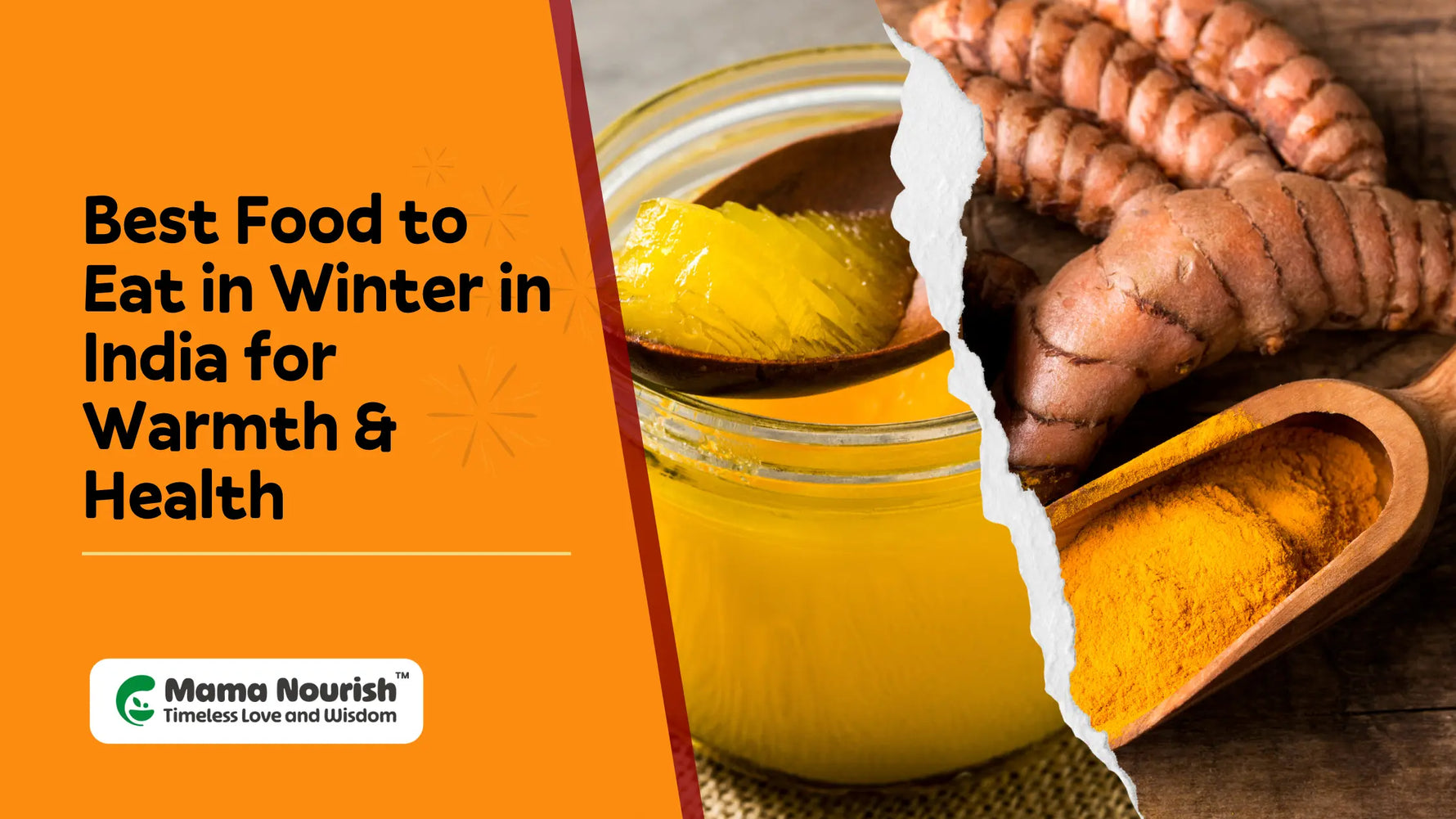
Best Food to Eat in Winter in In...
How about having a hot, comforting coffee on a chilly winter day, wrapped in a cosy blanket with warmth spreading over your heart and soul– well, during winter, we crave warmth and energy to fuel up to enjoy cosy winter vibes.
As the old saying goes–seasonal and local ingredients are the best, winter season is no exception. Our geographically rich country has numerous winter-season foods in India and nutrient-rich superfoods. These ingredients are not only healthy but can also be made into delicious dishes to satisfy winter cravings.
Here’s a list of the best food to eat in winter in India to make this chilly season wholesome. But first, let’s explore why we tend to feel hungrier in winter.
Why We Eat More in Winter: Understanding Seasonal Cravings?
One of the major reasons is the decreasing serotonin or the happy hormone production in the brain, leading to cravings for carbs to boost mood and energy. The other reasons include dehydration from heating, craving for warmth, hormonal shifts and, of course, emotional eating due to boredom or seasonal stress—especially if you are not too fond of cold days.
The general tendency is to go for sugary drinks or refined and dense carbs for a quick fuel up –even if you plan to enjoy a hot soup, do you know most of the instant Soup mixes are ultra-processed and even high in refined sugar?
So, the best way is to follow grandma's advice: seasonal and local–eating what naturally grows in the season and is locally available.
Let's go through some of the healthy winter foods lists and ways to add them to your diet.
14 Best Food to Eat in the Winter Season
1. Ginger
Ginger is called the universal medicine in Ayurveda, and it is a must-have for Indian cuisine. Today, it's one of the most sought-after spices not just for its gingerly taste but due to its evidence-based extensive health benefits.
According to scientific studies, ginger has antioxidant properties, which can help boost immunity, may aid in weight loss, manage cholesterol levels, lower blood sugar, reduce nausea, aid digestion and be good for the brain and heart. Additionally, the antimicrobial nature of ginger helps in fighting infections.
Additionally, ginger is known for its warming properties hence ideal for the winter season
Being a common kitchen ingredient in Indian households, there are many common dishes with Ginger. You can add ginger in numerous ways to your diet—in soups, curries, herbal teas, or even make them into sweets like dry ginger powder or Sonth ke laddu today, they are even used in making snack bars.
Ginger lemon tea
2. Turmeric
Turmeric is a healthy ingredient, and one of the best the best winter season food in India that goes well with season. This common Kitchen ingredient has many scientifically proven health benefits.
Turmeric is anti-inflammatory, may aid in boosting antioxidant activity, warms the body and is good for the brain and heart.
The turmeric powder is added in many Indian curries plus you can make tea, golden milk or smoothie or add them while making soups. Turmeric milk haldi ka doodh, or golden milk, can be made by heating milk in a saucepan until it boils, then adding turmeric and black pepper– stir well, and serve hot or warm for a healthy cosy winter day!
Turmeric milk / golden milk/ haldi ka doodh
3. Amla (Indian Gooseberry)
Amla or Indian gooseberry is a nutrient powerhouse—especially great to have during the winter season since it contains vitamin C, which boosts the immune system and protects against seasonal colds and flu. It is one of the best food to eat in winter season.
According to scientific studies, Amla has numerous health benefits, including antioxidant, anti-inflammatory, and antimicrobial properties. It also supports liver, heart, brain, and immune health while helping manage diabetes and aiding in digestion.
Some of the easiest ways to add amla to your diet are by making amla juice or smoothie, eating it raw, or making healthy pickles.
4. Sesame Seeds (Til)
The sesame or til seeds have been part of Indian cuisine and cultural practices since ancient times.
Sesame seeds or til seeds are a nutrient powerhouse–provide protein, minerals like iron and calcium and essential vitamins. Plus it's a healthy fat source.
According to studies–the health benefits of sesame seeds include the presence of antioxidants, lowering cholesterol and protecting the liver, kidneys, and heart. Additionally, they have anti-inflammatory and anti-tumour effects, making them an excellent addition to a healthy winter diet.
Traditionally Til laddu and chikki are made during the winter season. You can sprinkle sesame seeds over your favourite dishes or make tahinì; munching on sesame-infused healthy energy bars or healthy dips is another option.
Til laddu
5. Jaggery
Jaggery– the traditional sweetener made from sugarcane or date palm, holds a special place in Indian cuisine and culture, especially during winter.
Known by various regional names such as "Gur" in Hindi, "Vellam" in Tamil, "Bella" in Kannada, "Gul" in Marathi, "Bellam" in Telugu, and "Sharkara" in Malayalam, jaggery is a must-have in winter due to its warming properties and nutrient-rich profile.
Popular dishes include Gur ki Roti, Chikki, Adhirasam (a Tamil Nadu sweet made with rice flour and jaggery), and Pithas in Bengal, Assam and Odisha and various laddus like gond laddu, pinnis, Narkel naru or coconut laddus, dry fruit laddus, sesame laddus to name a few. Today they are also used as a healthy sweetener in some nutrition bars.
Additionally, scientific studies show that it improves digestion, detoxifies the liver, boosts energy, purifies the blood and combats toxins.
This natural source of iron aids in boosting haemoglobin levels and is packed with B vitamins and minerals like calcium, zinc, phosphorus and copper.
Narkel Naru, a traditional Bengali sweet, is crafted using coconut and nolen gur or jhola gur, which is date palm jaggery.
6. Bajra (Pearl Millet) & Ragi millets (Finger millet)
These gluten-free millets are great additions to a healthy winter diet and are a must-have on your winter food list.
The bajra or pearl millet is a source of omega-3 fatty acids and minerals like magnesium, copper, manganese, potassium, phosphorus, calcium and iron.
Bajra, being rich in fibre, is another bonus. It aids digestion and is known for helping in managing blood sugar. It provides a healthy dose of vitamin B and vitamin A, provides energy and immunity, and is good for the skin. Additionally, Bajra may promote weight loss and heart health.
Millet laddu
The Ragi is another nutrient-rich, warming food, high in fibre and Calcium (344 mg/100 g) and provides essential minerals like phosphorus & Iron and A, B vitamins, and tocopherol.
Other health benefits include managing blood sugar, antioxidant activity, boosting immunity and may help to deal with anxiety, insomnia and depression.
Both Millets can be used to make different dishes like porridges, upma, dosa, roti, and laddus-if you are too busy to cook, check out our healthy millet bars or wholesome millet Laddubars. It is also one of the best food to eat in winter season.
Ragi roti
7. Ghee
Ghee is famous for its cooling nature— making it ideal for the winter season
Ghee is great for winter as it provides energy and supports mental sharpness and overall physical well-being. Ghee is packed with nutrients such as vitamin A, omega-3 fatty acids, and conjugated linoleic acid.
According to studies, ghee is a storehouse of essential fats and antioxidants, ghee helps detoxify the body, enhances skin radiance, and is good for the eyes. When consumed in the right quantities, ghee promotes holistic wellness, making it a golden addition to your winter pantry.
Ghee is integral to many dishes ranging from Khichdi, dal tadka, pulao, halwa, dosa, Pongal, puran poli, ladoo, upma, pulao, gajar ka halwa, and the list goes on. You can also have rice with a dollop of ghee or spread on rotis or parathas or try a ghee coffee.
Khichdi–a wholesome winter comfort food
8. Fenugreek
Fenugreek, a magic ingredient from grandma's kitchen— is antidiabetic, supports heart health, aids digestion and boosts the immune system with its antimicrobial properties, making it an excellent warming ingredient for winter meal plans.
In addition to being an excellent source of protein, it's rich in iron—providing an impressive 262% DV, a good source of dietary fibre and B vitamins.
It is known to stimulate milk production in new mothers. Made with powdered fenugreek seeds, wheat flour, jaggery, dry fruits, seeds and ghee, these ladoos are packed with health benefits.
Fenugreek & Fenugreek laddu
Some other ways to add fenugreek to your diet are by soaking the seeds overnight and consuming them on an empty stomach or using them to temper curries and dals. Fresh fenugreek leaves (methi) can be added to parathas, theplas, sabzis or dosa, while dried leaves (kasuri methi) are an excellent seasoning in soups and curries.
9. Gond
Gond laddus also called Gond Panjiri, Gondh Laddu, Pinni in the north, Dinkache Laddu, Gundar Ladoo in Western India, and Thumma Jiguru in the South are another warming nutritious winter treat from India–the key ingredient gond or Gum arabica or Gondh, Gundar, and Thumma Jinguru is the edible gum from gum arabic tree (Babul or kikar).
Apart from being a cherished post-parturition recipe – traditionally made by mothers and mothers-in-law to daughters and daughters-in-law, the gond laddu is a nourishing treat for everyone due to the health benefits offered by gond.
The notable Benefits of Gond Acacia/ Acacia gum or Arabic gum, based on scientific studies, include aiding in weight loss, providing fibre content, helping in Cholesterol Management, good for kidneys, aiding in Metabolism, and helping the extraction of calcium. Plus it's a Prebiotics and anti-diabetic food Ingredient.
So, how about having a gond laddu to warm up on winter days? If you are too busy to cook, try our gond laddubar, exclusively made with kitchen ingredients and based on traditional recipes from a real grandmother.
Pinni or Gond Laddu
10. Almonds & Walnuts
Walnuts and almonds are winter superfoods, packed with nutrients that help you stay healthy and energized during the cold months.
Rich in healthy fats, protein, and fibre, these nuts provide warmth and sustain energy levels, making them ideal for combating winter lethargy.
Walnuts are an excellent source of omega-3 fatty acids, which support brain health and reduce inflammation, while almonds, loaded with vitamin E and antioxidants, nourish the skin and strengthen immunity.
Enjoy them as a mid-morning snack, blend them into warm porridges, eat them after soaking make dry fruit laddus or go for a dry fruit healthy energy bar for a healthy fuel up.
Dry fruit Laddu
11. Sweet potatoes and Carrots
Winter in India brings with it a bounty of nutrient-rich root vegetables, perfect for keeping the body warm and energised.
Carrots and sweet potatoes, in particular, are excellent choices for this season.
Carrots are loaded with beta-carotene, which converts to vitamin A and boosts immunity while promoting healthy skin—a great blessing during dry winters.
Sweet potatoes—a storehouse of complex carbohydrates and fibre provide vitamin C, which is important for immunity, especially in the winter season. Being naturally sweet it's a source of energy and helps combat seasonal fatigue.
Other root vegetables like radish (mooli), beetroot, and turnip (shalgam) are also great additions to your winter diet as they are seasonal hence fresh ones are easily available.
You can enjoy these roasted with spices, in comforting stews, warming soups or as part of a mixed vegetable curry.
Carrot soup
Another great way to add carrots to your diet is by making Gajar halwa. It is a traditional winter delicacy, especially in the Northern parts. Use natural sweeteners like jaggery or date in the place of sugar.
Gajar Halwa/ carrot halva
12. Leafy Greens
It's impossible to imagine indian winters without saag–and This classic North Indian winter dish is prepared by slow-cooking a blend of leafy greens such as mustard, spinach, and bathua. It has been a staple in traditional winter diets for generations.
In fact, eating a variety of nutrient-rich leafy greens that thrive in the cooler climate, is good for health in winter.
Spinach (palak) has antioxidants that boost immunity. It provides iron and calcium. Mustard greens (sarson) are another must-have; they provide vitamins A, C, and K, ideal for strengthening bones and promoting healthy skin. While amaranth leaves (chaulai) are great for maintaining heart health.
These greens can be added to your diet by making dishes like saag, parathas, dals, or soups, offering warmth, flavour, and nutrition throughout the season.
Saag
13. Guava
Guava is a traditional winter season food in India consumed in our country and packed with vitamin C and antioxidants that strengthen immunity and protect against seasonal illnesses.
Additionally, Its high fibre content aids digestion, while the natural sugars provide sustained energy to keep you active during chilly days. The fruit's low glycemic index makes it a healthy option for managing blood sugar levels, and its rich iron content.
You can enjoy guava raw or with a sprinkle of seasoning of your choice, as a juice, smoothies or in fruit salads.
14. Nutmeg
Nutmeg is a warming spice grown in India that's perfect for winter.
Rich in antioxidants, it supports immunity and helps combat seasonal infections. Nutmeg is also prized for its aroma and calming properties, making it an excellent remedy for improving sleep during chilly nights. Additionally, it aids digestion and enhances metabolism, which is especially helpful when indulging in heavy winter meals.
Sprinkle a pinch of nutmeg into warm milk, or add them while making desserts or in spice blends for curries.
And finally here are some healthy eating tips for a worry-free winter!
Note: article is provided for informational purposes only. Consult a healthcare professional if you are making dietary changes as individual nutritional needs vary.

